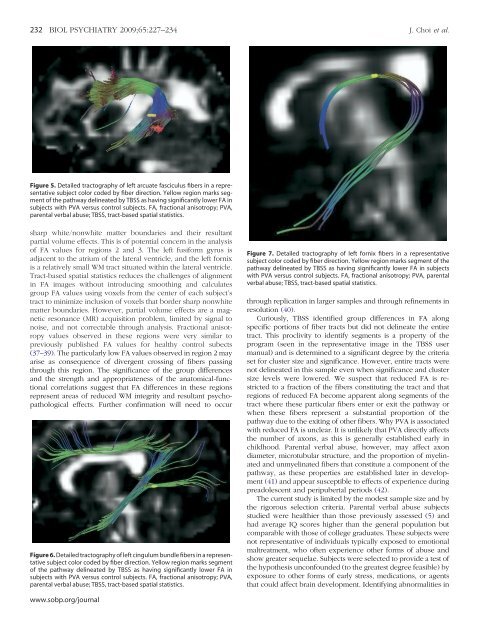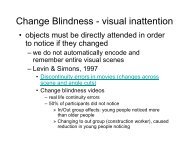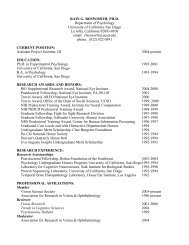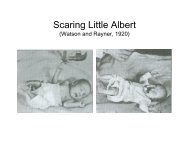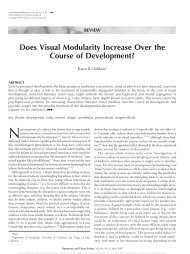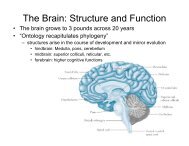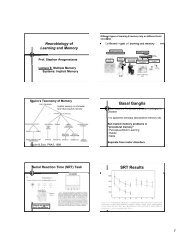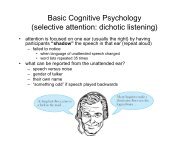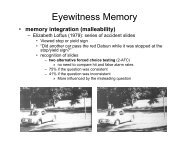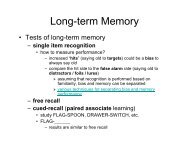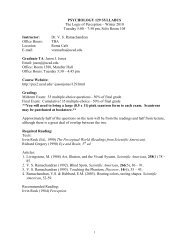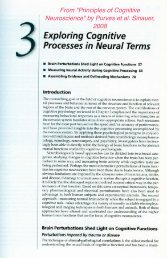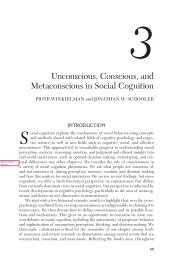Preliminary Evidence for White Matter Tract Abnormalities in Young ...
Preliminary Evidence for White Matter Tract Abnormalities in Young ...
Preliminary Evidence for White Matter Tract Abnormalities in Young ...
Create successful ePaper yourself
Turn your PDF publications into a flip-book with our unique Google optimized e-Paper software.
232 BIOL PSYCHIATRY 2009;65:227–234 J. Choi et al.<br />
Figure 5. Detailed tractography of left arcuate fasciculus fibers <strong>in</strong> a representative<br />
subject color coded by fiber direction. Yellow region marks segment<br />
of the pathway del<strong>in</strong>eated by TBSS as hav<strong>in</strong>g significantly lower FA <strong>in</strong><br />
subjects with PVA versus control subjects. FA, fractional anisotropy; PVA,<br />
parental verbal abuse; TBSS, tract-based spatial statistics.<br />
sharp white/nonwhite matter boundaries and their resultant<br />
partial volume effects. This is of potential concern <strong>in</strong> the analysis<br />
of FA values <strong>for</strong> regions 2 and 3. The left fusi<strong>for</strong>m gyrus is<br />
adjacent to the atrium of the lateral ventricle, and the left <strong>for</strong>nix<br />
is a relatively small WM tract situated with<strong>in</strong> the lateral ventricle.<br />
<strong>Tract</strong>-based spatial statistics reduces the challenges of alignment<br />
<strong>in</strong> FA images without <strong>in</strong>troduc<strong>in</strong>g smooth<strong>in</strong>g and calculates<br />
group FA values us<strong>in</strong>g voxels from the center of each subject’s<br />
tract to m<strong>in</strong>imize <strong>in</strong>clusion of voxels that border sharp nonwhite<br />
matter boundaries. However, partial volume effects are a magnetic<br />
resonance (MR) acquisition problem, limited by signal to<br />
noise, and not correctable through analysis. Fractional anisotropy<br />
values observed <strong>in</strong> these regions were very similar to<br />
previously published FA values <strong>for</strong> healthy control subects<br />
(37–39). The particularly low FA values observed <strong>in</strong> region 2 may<br />
arise as consequence of divergent cross<strong>in</strong>g of fibers pass<strong>in</strong>g<br />
through this region. The significance of the group differences<br />
and the strength and appropriateness of the anatomical-functional<br />
correlations suggest that FA differences <strong>in</strong> these regions<br />
represent areas of reduced WM <strong>in</strong>tegrity and resultant psychopathological<br />
effects. Further confirmation will need to occur<br />
Figure 6. Detailed tractography of left c<strong>in</strong>gulum bundle fibers <strong>in</strong> a representative<br />
subject color coded by fiber direction. Yellow region marks segment<br />
of the pathway del<strong>in</strong>eated by TBSS as hav<strong>in</strong>g significantly lower FA <strong>in</strong><br />
subjects with PVA versus control subjects. FA, fractional anisotropy; PVA,<br />
parental verbal abuse; TBSS, tract-based spatial statistics.<br />
www.sobp.org/journal<br />
Figure 7. Detailed tractography of left <strong>for</strong>nix fibers <strong>in</strong> a representative<br />
subject color coded by fiber direction. Yellow region marks segment of the<br />
pathway del<strong>in</strong>eated by TBSS as hav<strong>in</strong>g significantly lower FA <strong>in</strong> subjects<br />
with PVA versus control subjects. FA, fractional anisotropy; PVA, parental<br />
verbal abuse; TBSS, tract-based spatial statistics.<br />
through replication <strong>in</strong> larger samples and through ref<strong>in</strong>ements <strong>in</strong><br />
resolution (40).<br />
Curiously, TBSS identified group differences <strong>in</strong> FA along<br />
specific portions of fiber tracts but did not del<strong>in</strong>eate the entire<br />
tract. This proclivity to identify segments is a property of the<br />
program (seen <strong>in</strong> the representative image <strong>in</strong> the TBSS user<br />
manual) and is determ<strong>in</strong>ed to a significant degree by the criteria<br />
set <strong>for</strong> cluster size and significance. However, entire tracts were<br />
not del<strong>in</strong>eated <strong>in</strong> this sample even when significance and cluster<br />
size levels were lowered. We suspect that reduced FA is restricted<br />
to a fraction of the fibers constitut<strong>in</strong>g the tract and that<br />
regions of reduced FA become apparent along segments of the<br />
tract where these particular fibers enter or exit the pathway or<br />
when these fibers represent a substantial proportion of the<br />
pathway due to the exit<strong>in</strong>g of other fibers. Why PVA is associated<br />
with reduced FA is unclear. It is unlikely that PVA directly affects<br />
the number of axons, as this is generally established early <strong>in</strong><br />
childhood. Parental verbal abuse, however, may affect axon<br />
diameter, microtubular structure, and the proportion of myel<strong>in</strong>ated<br />
and unmyel<strong>in</strong>ated fibers that constitute a component of the<br />
pathway, as these properties are established later <strong>in</strong> development<br />
(41) and appear susceptible to effects of experience dur<strong>in</strong>g<br />
preadolescent and peripubertal periods (42).<br />
The current study is limited by the modest sample size and by<br />
the rigorous selection criteria. Parental verbal abuse subjects<br />
studied were healthier than those previously assessed (5) and<br />
had average IQ scores higher than the general population but<br />
comparable with those of college graduates. These subjects were<br />
not representative of <strong>in</strong>dividuals typically exposed to emotional<br />
maltreatment, who often experience other <strong>for</strong>ms of abuse and<br />
show greater sequelae. Subjects were selected to provide a test of<br />
the hypothesis unconfounded (to the greatest degree feasible) by<br />
exposure to other <strong>for</strong>ms of early stress, medications, or agents<br />
that could affect bra<strong>in</strong> development. Identify<strong>in</strong>g abnormalities <strong>in</strong>


